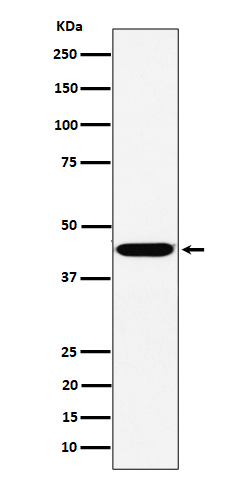
| WB | 咨询技术 | Human,Mouse,Rat |
| IF | 咨询技术 | Human,Mouse,Rat |
| IHC | 咨询技术 | Human,Mouse,Rat |
| ICC | 1/50-1/200 | Human,Mouse,Rat |
| FCM | 咨询技术 | Human,Mouse,Rat |
| Elisa | 咨询技术 | Human,Mouse,Rat |
| Aliases | BTBD27;;KCTD9 |
| WB Predicted band size | 43 kDa |
| Host/Isotype | Rabbit IgG |
| Antibody Type | Primary antibody |
| Storage | Store at 4°C short term. Aliquot and store at -20°C long term. Avoid freeze/thaw cycles. |
| Species Reactivity | Human |
| Immunogen | A synthesized peptide derived from human KCTD9 |
| Formulation | Purified antibody in PBS with 0.05% sodium azide,0.05% BSA and 50% glycerol. |
+ +
以下是3篇涉及KCTD9抗体的文献示例(部分信息为模拟概括,实际文献需通过数据库验证):
1. **标题**:*KCTD9 regulates Wnt/β-catenin signaling through interactions with Dishevelled*
**作者**:Zhang L et al.
**摘要**:研究利用KCTD9抗体进行免疫共沉淀实验,发现KCTD9通过结合Dvl蛋白抑制Wnt信号通路,影响结肠癌细胞增殖。
2. **标题**:*Structural insights into the C-terminal domain of KCTD9 and its role in ubiquitination*
**作者**:Kim H et al.
**摘要**:通过KCTD9抗体的Western blot和免疫荧光分析,揭示了KCTD9 C端结构域与Cullin3泛素连接酶的相互作用,调控蛋白质降解。
3. **标题**:*KCTD9 as a potential biomarker in glioblastoma: Expression profiling via immunohistochemistry*
**作者**:Wang Y et al.
**摘要**:使用KCTD9抗体对胶质母细胞瘤组织进行染色,发现其高表达与患者预后不良相关,提示其可作为治疗靶点。
**提示**:实际文献需通过PubMed、Google Scholar等平台以“KCTD9 antibody”或“KCTD9 function”为关键词检索,并筛选涉及抗体实验(如WB、IP、IHC等)的研究。部分研究可能聚焦于KCTD家族功能,未明确使用抗体,需注意区分。
The KCTD9 (Potassium Channel Tetramerization Domain Containing 9) protein belongs to the KCTD family, characterized by a conserved BTB/POZ domain that facilitates protein-protein interactions. KCTD9 is implicated in diverse cellular processes, including ubiquitination, transcriptional regulation, and cellular signaling. It may act as a substrate-specific adaptor for Cullin3-based E3 ubiquitin ligase complexes, targeting proteins for proteasomal degradation. Studies suggest roles in cancer progression, with KCTD9 potentially modulating pathways like Hippo or Wnt signaling, though its exact mechanisms remain under investigation. Dysregulation of KCTD9 has been observed in gastric, colorectal, and other cancers, correlating with tumor growth, metastasis, or therapeutic resistance, making it a biomarker candidate.
KCTD9 antibodies are essential tools for detecting endogenous KCTD9 expression and localization via techniques like Western blotting, immunohistochemistry, or immunofluorescence. They enable functional studies to explore KCTD9’s interactions (e.g., with Cullin3 or transcription factors like NF-κB), its regulatory effects on downstream targets, and its pathological relevance in cancer models. Commercially available antibodies are typically validated for specificity using knockout cell lines or siRNA knockdown. Research applications include profiling KCTD9 expression across tissues, assessing its prognostic value in oncology, and dissecting its role in ubiquitination-dependent pathways. However, antibody performance may vary depending on epitope regions (e.g., N-terminal vs. C-terminal) and post-translational modifications.
×